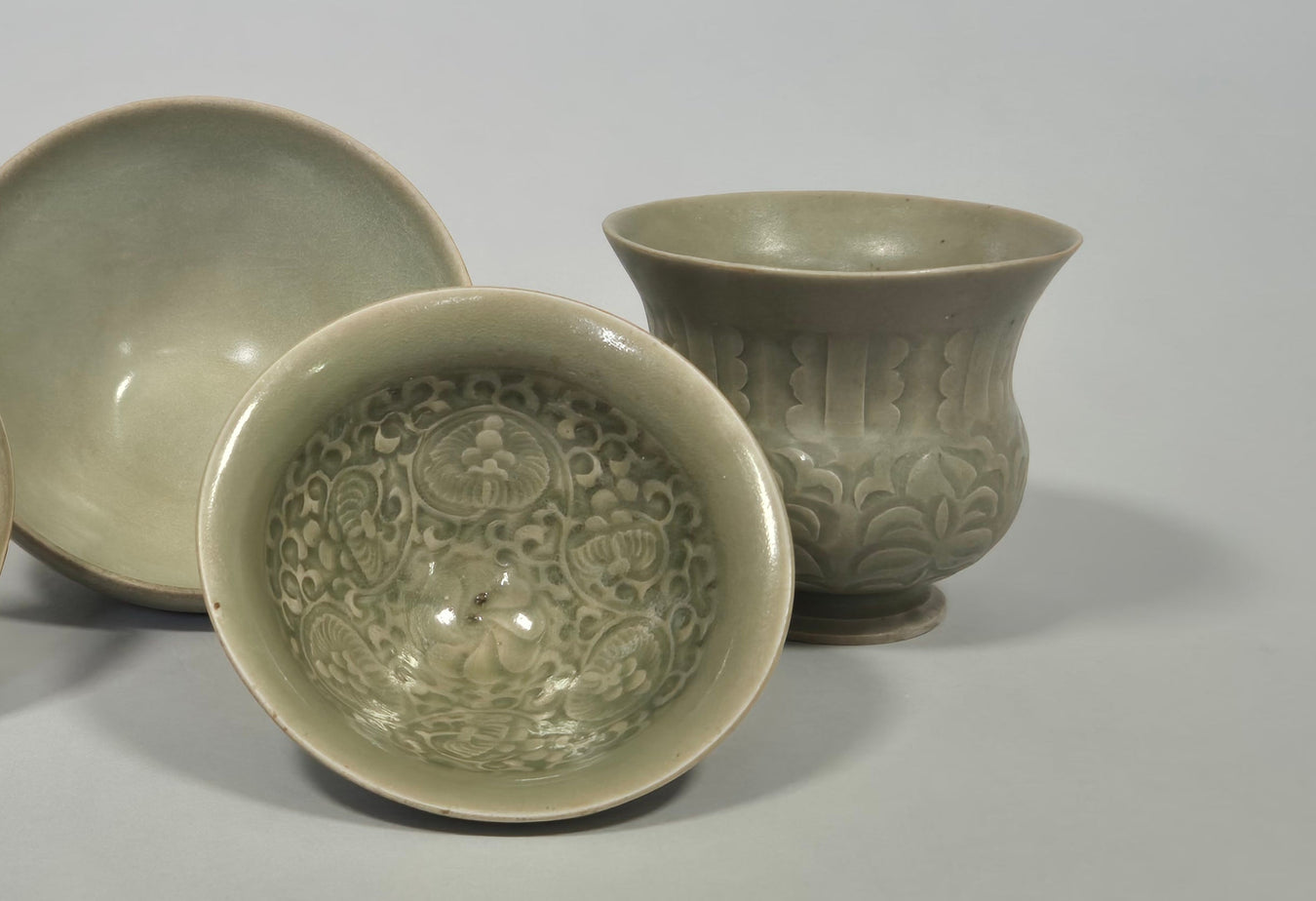Northern Celadon

Yaozhou is one of the most notable kiln centers in Chinese history. The kilns are located in today’s Tongchuan city (formerly Tongguan) in Shaanxi province. During the Song dynasty (960–1279) the area was under Yaozhou prefecture, which gave the kilns their name. Most kiln sites are in present-day Huangpu (Huangbao) in Tongchuan, but others exist at Chenlu, Lidipo, Shangdian, and Yuhuagong.
The origins of the site go back to Neolithic times. In the Tang dynasty it was an important production area for black wares, white wares, and sancai earthenwares. It was only in the late 9th century that celadon wares began to be made here, likely influenced by the success of the Yue kilns in southern China.
Before large-scale excavations at Yaozhou, little was known about wares from the Five Dynasties period (907–960). Since the mid-1980s, excavations at Huangpu have uncovered more than a million fragments ranging from the Tang to the Yuan dynasties. The most important finds from the Five Dynasties include thinly potted vessels with evenly applied sky-blue glaze and glossy surfaces. Forms include bowls, cup stands, dishes, bottles, and vases. These pieces show fine workmanship and good vitrification, resembling later Northern Song Ru wares (960–1127). Their glaze is also similar to Korean celadon of the 11th–12th centuries, suggesting that Yaozhou influenced Korean techniques.
The discovery of sky-blue Yaozhou wares helps fill a gap in the history of northern celadon production and shows their connection to Northern Song Ru wares. Some bowls from the site bear the incised character guan (“official”), suggesting they were made as tribute pieces for the court during the Five Dynasties. Other fragments, such as ewers with carved peony designs, show that certain heirloom pieces once thought to come from Eastern kilns were in fact produced at Yaozhou in the Five Dynasties or early Northern Song. Around the 10th century, potters switched from wood-firing to coal, which changed the glaze colors from bluish to green, olive-green, and sometimes amber.
During the Northern Song dynasty, kilns lined both sides of the Qishui River in Huangpu, forming a large production center. The brick-built mantou kilns had horseshoe-shaped plans, and typical firing temperatures reached about 1300°C. At this time Yaozhou produced mostly celadon wares with some iron-rich brown or black-glazed pieces. The celadon bodies were grayish-white, and glazes usually appeared green with a yellow tone. The best examples had a glossy gray-green glaze filled with tiny bubbles. Forms were highly varied, including everyday objects such as bowls, bottles, jars, incense burners, headrests, cosmetics boxes, alms bowls, lamps, basins, and even chess pieces, figures, and matching sets of ewers, cups, and stands.
Decoration was rich in the Northern Song. Many designs featured plants, figures, and animals, such as peonies, lotuses, chrysanthemums, scholars, children, waves, fish, ducks, and birds. Celadons were often decorated with carved, incised, or molded motifs, producing striking effects. The thicker body of Yaozhou ware, compared with Yue wares, allowed potters to create three-dimensional patterns. The glaze pooled in carved lines, appearing lighter where thin and darker where thick, which emphasized the designs. Carved motifs were sometimes enhanced with combed details to add realism. Overall, the style is marked by clear, strong lines and lively decoration.
Molded designs appeared in the mid-Northern Song, marking a new stage. The hump molds, made from the same clay, were carved with designs and fired for repeated use. A leather-hard vessel was pressed over the mold to transfer the pattern, then trimmed, glazed, and fired. Molded motifs usually decorated the interiors of dishes, bowls, and washers. Subjects included flowers, children at play, the “hundred antiques” (a collection of classical objects), apsaras, and moths, all arranged with balanced compositions and clear outlines. The Yaozhou kilns were privately run, not imperial, but their wares were of such high quality that some were accepted as tribute to the court.
Yaozhou ware in the Jin and Yuan dynasties
The main production of the Northern Song continued into the Jin dynasty, with some changes in style. Designs became simpler and sometimes larger, while some wares revived earlier Five Dynasties forms. Pieces with translucent bluish-green glazes and little decoration reappeared, some with very pale clay giving the glaze a moon-white tone. Potters also began to copy bronze forms, reflecting new tastes.
In the Yuan dynasty (1271–1368), most of the great Song kiln centers declined, as demand shifted to large, colorful wares such as the blue-and-white porcelains of Jingdezhen. While the Yaozhou site report does not cover the Yuan period, several Yuan pieces are preserved in the Yaozhou Kiln Museum.
The influence of Yaozhou
Another major northern celadon kiln center was in Linru, Henan, about 320 km east of Yaozhou. Many kiln sites have been found along the Yellow River, active from the early 12th century. Linru wares are often hard to distinguish from Yaozhou, though Linru glazes are generally greener and less transparent, and their clay is whiter. Linru mostly made utility wares such as bowls, cups, and saucers, with fewer bottles or display pieces. Their main decorative method was molding, while carving and painting were rare.
Yaozhou also influenced southern kilns, including Xicun in Guangdong and Yongfu and Rongxian in Guangxi. These centers produced similar wares, spreading the Yaozhou style more widely.
